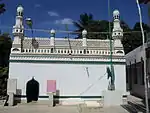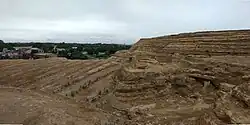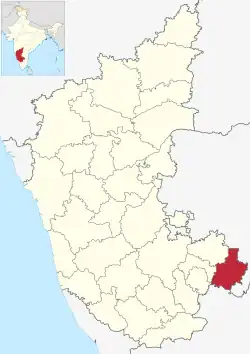Kolar district | |
|---|---|
.JPG.webp)   _at_Avani.JPG.webp)  Someshwara Temple in Kolar, Tomb of Hyder Ali father, Ramalingeshwara Temple at Avani, Mine waste in Kolar Gold Fields, Kolaramma Temple at Kolar | |
 Location in Karnataka | |
| Country | |
| State | Karnataka |
| Division | Bengaluru |
| Headquarters | Kolar |
| Government | |
| • District Commissioner | Venkata Raja (IAS) |
| Area † | |
| • Total | 4,012 km2 (1,549 sq mi) |
| Population (2011)† | |
| • Total | 1,536,401 |
| • Density | 384/km2 (990/sq mi) |
| Languages | |
| • Official | Kannada |
| Time zone | UTC+5:30 (IST) |
| ISO 3166 code | IN-KA-KL |
| Vehicle registration | KA-07, KA-08 |
| Sex ratio | 976 ♀ / 1000♂ |
| Literacy | 74.33% |
| Lok Sabha constituency | Kolar Lok Sabha constituency |
| Precipitation | 724 millimetres (28.5 in) |
| Website | kolar |
Kolar district (ⓘ) is a district in the state of Karnataka, India.
Kolar (ಕೋಲಾರ) is the district headquarters. Located in southern Karnataka, it is the state's easternmost district. The district is surrounded by the Bangalore Rural district on the west, Chikballapur district on the north, the Chittoor district and Annamayya district of Andhra Pradesh on the east and the Krishnagiri district of Tamil Nadu on the south.
On 10 September 2007, it was bifurcated to form the new district of Chikballapur.[1] Due to the discovery of the Kolar Gold Fields, the district has become known as the "Golden Land" of India.
People are citing that still gold is present in Kolar Gold Fields mines abundantly and also exists in Mulbagal, Kolar, Bangarapet, Malur, Srinivasapura taluks of Kolar District. However it must have to be confirmed by the state and as well central government authorities.
History
_at_Avani.JPG.webp)
Kolar, formerly known as Kolahala, Kuvalala and Kolala, was called Kolahalapura during the Middle Ages. In Kannada, kolahalapura means "violent city" and it was the battlefield for the warring Chalukyas in the north and the Cholas in the south. In 1004 AD, the Cholas annexed Kolar until 1116. Vishnuvardhana (1108-1142) freed Gangavadi from the Cholas and, to commemorate his victory, built the Chennakesava Temple at Belur.
Kolaramma and Someshwara are notable temples in Kolar. The Kolaramma temple, built in Dravida Vimana style during the second century, is dedicated to Shakti. It underwent renovations under Rajendra Chola I in the 10th century and the Vijayanagara kings in the 15th century.[2][3] Someswara Temple is an example of 14th-century Vijayanagara art.
Kolar's early history was compiled by Fred Goodwill, superintendent of the Wesleyan Tamil mission in Bangalore and the Kolar Gold Fields, and his studies have been published in a number of journals.[4][5][6] Older than Bangalore, Kolar dates back to the second century. The Western Gangas made Kolar their capital, ruling Mysore, Coimbatore, and Salem. During the 13th century Bhavanandi composed Nannool, his treatise on Tamil grammar.
Under the Cholas, King Sridhar kora (ruled 970–985) reportedly built the temple for Renuka and founded the city of Kolaahalapuram. Veera Chola, Vikrama Chola and Rajendra Chola I built stone structures with inscriptions at Avani, Mulbagal, Sitti Bettta and elsewhere. Chola inscriptions, which document the rule of Adithya Chola I (871-907), Raja Raja Chola I and Rajendra Chola I of Kolar, refer to Kolar as Nikarili Cholamandalam and Jayam Konda Chola Manadalam. Inscriptions from Rajendra Chola I also appear on the Kolaramma Temple. Many Siva temples were built in Kolar during the reign of the Cholas, including the Someshwarar and Sri Uddhandeshwari Temples at Maarikuppam Village, the Eswaran Temple at Oorugaumpet and the Sivan Temple at Madivala Village. Chola rule of Kolar lasted until 1116. The inscriptions are neglected, and some have been vandalised.
In 1117 Kolar became part of the Hoysala Empire; in 1254 it was bestowed to Ramanatha, one of King Someshwara's two sons. The Hoysala were defeated by the Vijayanagara Empire, which ruled Kolar from 1336 to 1664. During this period, the Sri Someshwara Temple at Kolar was built.
For 50 years in the 17th century Kolar was under Maratha rule as part of the Jagir of Shahaji, followed by 70 years of Muslim rule. In 1720 it became part of the Province of Sira, with Fateh Mohammed (the father of Hyder Ali) the province's Faujdar. Kolar was then ruled by the Marathas, the Nawab of Cuddapah, the Nizam of Hyderabad and Hyder Ali. It was under British rule from 1768 to 1770 before a brief Maratha rule followed by Hyder Ali. In 1791 Lord Cornwallis conquered Kolar and returned it to the Kingdom of Mysore in the peace treaty of 1792.
In the Kolar region, inscriptions document the reigns of the Mahavalis (Baanaas), the Pallavas and the Vaidumbaas.[4][5][6][7][8] Benjamin Lewis Rice recorded 1,347 inscriptions in the Kolar District, in the 10th volume of his Epigraphia Carnatica, of the inscriptions, 422 are in Tamil, 211 in Telugu. But the oldest are in Kannada. This was the original language. Tamil came in with the Cholas in the 11th century, and Telugu with Vijayanagar kings after the 15th. The period covered by the inscriptions is from 4th to the 18th century.[9]
List of tourist attractions in Kolar district
List of tourist attractions in Kolar district important temple and tourist attractions details are provided here
Taluks
Demographics
| Year | Pop. | ±% p.a. |
|---|---|---|
| 1901 | 392,651 | — |
| 1911 | 429,193 | +0.89% |
| 1921 | 436,066 | +0.16% |
| 1931 | 469,811 | +0.75% |
| 1941 | 555,545 | +1.69% |
| 1951 | 650,807 | +1.60% |
| 1961 | 721,822 | +1.04% |
| 1971 | 826,563 | +1.36% |
| 1981 | 1,044,394 | +2.37% |
| 1991 | 1,211,858 | +1.50% |
| 2001 | 1,387,062 | +1.36% |
| 2011 | 1,536,401 | +1.03% |
| Source: District website[10] | ||
In the 2011 census, the district had a population of 1,536,401[12]—roughly equal to that of Gabon[13] or Hawaii.[14] It ranked 324th of India's 640 districts).[12] The district has a population density of 384 inhabitants per square kilometre (990/sq mi),[12] with a growth rate of 11.04 percent from 2001 to 2011.[12] Kolar's sex ratio is 976 females per 1,000 males.[12] Its literacy rate is 74.33 percent. 31.25% of the population lives in urban areas. Scheduled Castes and Scheduled Tribes make up 30.32% and 5.13% of the population respectively.[12] The district has 15 towns and a total of 3,321 villages (2,889 inhabited villages and 432 uninhabited).
At the time of the 2011 census, 51.51% of the population spoke Kannada, 22.67% Telugu, 12.88% Urdu and 10.99% Tamil as their first language.[15] Kolar is part of Morasu Nadu, where both Kannada and Telugu language and culture blend. In 2001, Kannada, Telugu and Tamil were spoken by 40.50%, 33.27% and 11.80% of the population respectively.
Culture
The district's primary language is Kannada; Urdu, Tamil and Telugu are spoken by large minorities. Kolar Gold Fields (KGF) has an Anglo-Indian population. Festivals include the 13-day summer Karaga, celebrated in Kolar District, Kolar being one of the oldest Karaga traditions then followed in different regions of the district and usually beginning the first Friday after Ugadi; the water festival Theppothsava, and Dyavara.
Notable people
- L. Basavaraju - noted writer in Kannada
- Sir M. Visvesvaraya - Bharat Ratna and First Engineer of India
- D. V. Gundappa - Kannada poet
- K. C. Reddy - first Chief Minister of Karnataka
- Masti Venkatesh Ayengar - Kannada writer and Jnanpith Award recipient
- K. H. Muniyappa - Former Union Minister of state for Indian Railways; represented Kolar in the Parliament of India for six terms
- N. R. Narayana Murthy - Chairman and Chief Mentor of Infosys Technologies Limited
- Soundarya - South Indian film actress
- A. N. Prahlada Rao - author and crossword
- B. K. S. Iyengar - the founder of the style of yoga as exercise known as "Iyengar Yoga" and was considered one of the foremost yoga teachers in the world.
- Picchalli Srinivas - popular singer and theatre personality
Media
See also
References
- ↑ "A Handbook of Karnataka - Administration" (PDF). Government of Karnataka. pp. 354, 355. Archived from the original (PDF) on 8 October 2011. Retrieved 16 November 2010.
- ↑ "A green view". The Hindu. Chennai, India. 11 March 2006. Archived from the original on 23 August 2006. Retrieved 23 December 2010.
- ↑ "Temples of Karnataka - Kolar". templenet.com. Retrieved 23 December 2010.
- 1 2 "Nandiroog". The Quarterly Journal of the Mythic Society. 9: 298. 1918.
- 1 2 Goodwill, Fred (1918). "Nandidroog". The Quarterly Journal of the Mythic Society. 9–10: 300. Retrieved 27 August 2014.
- 1 2 Goodwill, Fred (1921). "The Religious and Military Story of Nudydurga". KGF Mining and Metallurgical Society (5).
- ↑ Srikumar, S (2014). Kolar Gold Field: (Unfolding the Untold) (International ed.). Partridge India. pp. 40–46. ISBN 9781482815078. Retrieved 27 August 2014.
- ↑ Chandrashekar, Gayatri (2015). Grit and Gold. Partridge Publishing. ISBN 9781482855845. Retrieved 11 July 2016.
- ↑ Rice, Benjamin Lewis (1994). Epigraphia Carnatica: Volume X: Inscriptions in the Kolar District. Mangalore, British India: Department of Archeology, Mysore State. p. 20. Retrieved 4 August 2015.
- ↑ "Kolar district at a glance" (PDF). Archived from the original (PDF) on 12 March 2011. Retrieved 22 December 2010.
- ↑ "Table C-01 Population by Religion: Karnataka". censusindia.gov.in. Registrar General and Census Commissioner of India. 2011.
- 1 2 3 4 5 6 "District Census Handbook: Kolar" (PDF). censusindia.gov.in. Registrar General and Census Commissioner of India. 2011.
- ↑ US Directorate of Intelligence. "Country Comparison:Population". Archived from the original on 13 June 2007. Retrieved 1 October 2011.
Gabon 1,576,665
- ↑ "2010 Resident Population Data". U. S. Census Bureau. Archived from the original on 9 August 2011. Retrieved 30 September 2011.
Hawaii 1,360,301
- 1 2 "Table C-16 Population by Mother Tongue: Karnataka". www.censusindia.gov.in. Registrar General and Census Commissioner of India.
- ↑ Kolaravani
- ↑ Kannada Thilaka